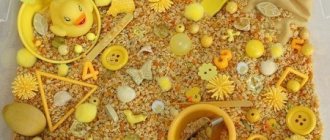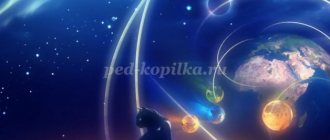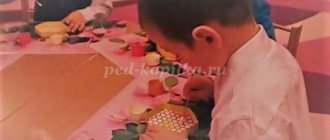MAGAZINE Preschooler.RF
Educational and game situation in the preparatory group “Cosmonaut’s Breakfast”Municipal autonomous preschool educational institution, child development center - kindergarten No. 7
Educator: Svetlana Aleksandrovna Golovyatenskaya, Krasnodar region, Kurganinsk
Goal: expanding children's understanding of space, constellations, using elements of research activities.
Tasks:
- the formation of children’s primary ideas about the features of the life of astronauts on the space station: nutrition, sleep, clothing, scientific activities, spacewalks, sports, recreation
- consolidation of knowledge about safety rules when conducting experiments
- application of knowledge, skills and abilities acquired in classes
- Educational:
- development of mental and speech activity, visual attention, perception, imagination
- development of dexterity, training of quick decision-making skills
- Educational:
- formation of positive interest in search activities, nurturing the desire to achieve results during experimentation.
Equipment:
Projector, screen, hoops according to the number of children, containers of water, food coloring, stir sticks, measuring cups, dough, board, rolling pin, molds, fruit, trays.
Preliminary work:
Conversations about space, looking at illustrations, encyclopedias, books about space. Productive activity: drawing - “Space through the eyes of a child” , making crafts about space together with parents. Game situations “Cosmodrome” , “Find the constellation” .
Progress of the OIC:
Cosmic music sounds.
Educator: Children, listen to a musical composition and try to imagine what a long journey this music invites you on. Why do you think so?
Children: Music is mysterious, mysterious, unusual, just like space! (slide 2)
A child dressed as an astronaut enters.
Cosmonaut: Hello guys, I was passing by and heard space music and came to see you. I want you to help me.
Educator: What happened to you?
Cosmonaut: I want to fly into space, but I don’t know anything about space.
Educator: (slide 3) The man looked at the starry sky, and he wanted to know what kind of stars they were, why they were so bright? They disappeared by morning only to appear the next night. And where the huge disk of the Sun sparkled during the day, dispersing the darkness, the MOON shone, which periodically changed its shape.
People did not understand why this was happening and could not explain it. But a millennium passed and they found answers to many questions.
Let us now remember everything that we know about space.
Educator: What is space?
Children: Space is the endless space that surrounds our Earth. Everything that exists in space is the Universe (slide 4).
Educator: What is in outer space?
Children: There are planets in outer space. (slide 5)
Educator: What planets do you know and how many are there?
Children: nine planets: Mercury, Venus, Earth, Mars, Jupiter, Saturn, Uranus, Neptune, Pluto.
Child: All the planets are in order,
Any of us can name:
- Once - Mercury,
- Two - Venus,
- Three - Earth,
- Four - Mars
- Five - Jupiter
- Six - Saturn
- Seven - Uranus,
- Behind him is Neptune.
He is the eighth in a row. And behind it, then, is the ninth planet, called Pluto.
Educator: People wanted to know if there is life on other planets? And if there is, who lives there? But to find out about this, you need to fly to these planets. Airplanes were not suitable for this, because the planets were very far away. And people came up with spaceships. What were they called?
Children: Rockets. (slide 6)
Educator: Who was the first astronaut? (slide 7)
Children: Yuri Alekseevich Gagarin.
Educator: Guys, what date is today?
Children: April 12.
Educator: What is celebrated on this day? (slide 
Children: On this day, April 12, Cosmonautics Day is celebrated. This holiday is primarily for astronauts and those who participate in the creation of space rockets.
Educator: April 12, 1961 on the ship “Vostok” Yu.A. Gagarin launched from the Baikonur and circled the earth. Guys, how many minutes?
Children: in 108 minutes.
Educator: By flying into space, a man proved that our planet, earth, has the shape of a ball (shows a globe). Flight Yu.A. Gagarin - opened the way for people into space.
Educator: What other astronauts do you know?
Children: Valentina Tereshkova, Leonid Popov, Alexey Leonov, Titov... (slide 9,10)
Yuri Gagarin.
In a space rocket called “Vostok”, he was the first on the planet to rise to the stars.
Spring Drops sings songs about this: Gagarin and April will be together forever.
Educator: For a long stay in space there is the International Space Station ISS. (slide 11)
Educator: Guys, why do you think people fly into space? What do astronauts do on a spaceship?
Children: The astronauts work; before the flight into space, scientists give the astronauts tasks. The astronauts carry them out, conduct experiments, record everything, and when they return to Earth, the records are passed on to scientists.
Educator: Astronauts go into outer space. Going into outer space means the astronaut leaves the station into space to carry out a task or repair.
Educator: How are the astronauts dressed? (slide 12)
Children: The astronauts are wearing a spacesuit.
Educator: The weight of the spacesuit depends on its purpose. The first spacesuits in which astronauts went into space weighed about 30 kg. Now the weight of the spacesuit does not exceed 8-10 kg. A spacesuit designed for spacewalks weighs about 110 kg.
What is weightlessness?
Children: Weightlessness is when a person and objects are very light and fly.
Educator: Cosmonauts have time to rest. Playing chess is an exciting activity. Astronauts on the space station wear a tank top with shorts or overalls. Instead of buttons there are zippers and Velcro: they won’t come off. The more pockets the better. Instead of shoes, thick socks are worn.
Astronauts sleep strapped in because there is zero gravity in space. Sleeping bags with zippers are attached directly to the walls.
Educator: What do astronauts eat?
Children's answers.
Educator: As you know, astronaut food is considered the healthiest food. And this is no coincidence. After all, the conditions in which astronauts find themselves for a long time are truly extreme. This is stress for the body, therefore, you need to be very careful about nutrition.
Healthy food for astronauts, rich in vitamins and microelements, is pre-processed to remove various microbes and other harmful substances.
But at the same time, the differences with ordinary earthly food are quite insignificant.
They prepare food for the astronauts, of course, on Earth, then the astronauts take it with them into space, it is already packaged in jars.
The main rule of lunch for astronauts is that there should not be any crumbs, as they will scatter and it will be impossible to catch them later, and they can get into the astronaut’s respiratory tract. That’s why they bake special bread for astronauts that doesn’t crumble. This is why bread is produced in small, specially packaged pieces. Before eating, it is heated, like other products that are in tin packages.
For drinking, special glasses were invented, from which astronauts suck the liquid.
The food is pureed, which looks like baby food but tastes suitable for adults. For example, the diet of astronauts includes such dishes as: meat with vegetables, prunes, cereals, currant, apple, plum juice, soups, chocolate cheese. The menu is quite varied, as you can see. The main thing is that their food should be in the form of a dried concentrate, sealed and sterilized. All you need to do is fill it with hot water, and you can refresh yourself. Now our ships and stations even have special stoves designed for heating space food.
But before any dish is added to the menu, it is given to the astronauts themselves for preliminary tasting.
Who among you wouldn’t want to fly into space if they would feed him like this?
Children's answers.
Educator: Astronauts must play sports every day.
The teacher turns to the astronaut: Are you doing exercises?
Cosmonaut: Yes, I do exercises every morning, guys, I invite you to exercise:
To become an astronaut, you need to learn a lot: To be agile and skillful, Very dexterous, very brave.
Gymnastics for astronauts
1. "Cosmonauts put on a spacesuit"
The legs are slightly apart, the feet are parallel, the arms are lowered, holding the hoop at diametrically opposite points. 1-rise on your toes, 2-raise the hoop horizontally up, look into it - inhale, 3 - lower your entire foot, 4- lower the hoop down - exhale. Movements are performed smoothly.
2. “Installing a solar sail on a ship”
Feet together, hoop underneath. 1- lift the hoop vertically up, put your right leg to the side on the toe, 2- tilt your torso to the right, 3- straighten up, put the hoop up, 4- put your leg down, lower the hoop down. The same to the left.
3. "Cosmonaut training in the pool"
Lie on your stomach, legs bent at the knees, hook the hoop over the toes. 1-3 – slowly straighten your legs, lift the hoop up, bend over – inhale, 4 – lower the hoop – exhale. Perform movements smoothly.
4. "Jump from outer space into a ship's hatch".
Stand straight, feet together, hands on your belt, hoop on the floor to the right. Jump into a hoop and back for 8 counts. For 6-8 counts – walking in place.
5. "Cosmonauts returning from training"
Walking in a column one at a time.
The Russian cosmonauts' menu looks something like this:
- First breakfast: biscuit, tea with lemon or coffee.
- Second breakfast: pork (beef), juice, bread.
- Lunch: chicken broth, prunes with nuts, juice (or milk soup with vegetables, ice cream and chocolate).
- Dinner: pork with mashed potatoes, cookies, cheese, milk.
The teacher invites the children to the laboratory to prepare breakfast for the astronaut. Children are divided into subgroups. Some prepare cookies, others fruit salad, and others compote. Afterwards everything is packed into containers and given to the astronaut.
The astronaut thanks the children for the knowledge they have acquired, for breakfast, and invites them to play the outdoor game “Cosmonauts.”
Before starting the game, it is necessary to draw several large triangles in the corners and sides of the site or hall - these are “rocket launch sites” . At each “rocket launch site” there are from 2 to 5 circles - “missiles” . Only one participant in the game can occupy the “Rocket” The total number of “missiles” must be less than the number of players. The participants in the game join hands and stand in a circle in the center of the court, they begin to move in a circle and recite loudly:
“Fast rockets are waiting for us for walks on the planets. Whichever one we want, we’ll fly to that one! But there is one secret in the game:
There is no room for latecomers!”
Saying the word “no!” children unclasp their hands and rush to the “rocket launch pads” , trying to occupy any free “rocket” . The losers are declared late for their flight and return to the center of the court. Successful “astronauts” can take turns announcing their route or telling where they are currently flying and what space objects are in their field of vision.
| Next > |
Organization of meals for children in kindergarten
Dishes acceptable for preparation in kindergarten are selected taking into account the age and daily needs of the child’s body. The menu is approved by the head of the institution for a period of at least 15 days. The products used for cooking are determined by the area of residence and nationality of the preschool children, as well as the presence or absence of health problems.
The meal plan includes breakfast, lunch, afternoon snack and dinner. In this case, breakfast should consist of a hot dish, a hot drink and bread. Lunch - first and second hot courses, drinks, snacks. The afternoon snack consists of a bakery product and a drink. Dinner includes hot food, salad and tea. If there is no product installed by the manual, an equivalent replacement is possible.
List of products recommended for use:
- Meat and fish products
- Boiled chicken eggs
- Milk products
- Vegetable and animal fats
- Confectionery
- Vegetable dishes
- Fruits
- Juice, tea, cocoa, compote
- Bread
- Salt
Prohibited for use:
- Products without preliminary heat treatment
- Canned food
- Shellfish
- Confectionery with cream filling
- Drinks containing caffeine
- Drinks containing dyes and carbon dioxide
Before approving the main menu, a tentative list of dishes is drawn up. They are prepared based on culinary technologies and recipe books developed specifically for preschool institutions.
Parents are informed every day about the list of products served to children during the day. This obligation is fulfilled by the head of the institution by posting the daily menu in groups, indicating the names of dishes, the weight of portions and a list of replaced products (if some children have allergic reactions or other pathologies).



